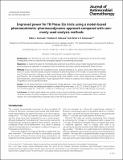Files in this item
Improved power for TB phase IIa trials using a model-based pharmacokinetic-pharmacodynamic approach compared with commonly used analysis methods
Item metadata
| dc.contributor.author | Svensson, Robin J. | |
| dc.contributor.author | Gillespie, Stephen H. | |
| dc.contributor.author | Simonsson, Ulrika S. H. | |
| dc.date.accessioned | 2017-06-05T14:30:07Z | |
| dc.date.available | 2017-06-05T14:30:07Z | |
| dc.date.issued | 2017-08-01 | |
| dc.identifier | 250039676 | |
| dc.identifier | 09ce80be-e9e7-49fe-9926-9cc7bef58864 | |
| dc.identifier | 85027198988 | |
| dc.identifier | 000406155400021 | |
| dc.identifier.citation | Svensson , R J , Gillespie , S H & Simonsson , U S H 2017 , ' Improved power for TB phase IIa trials using a model-based pharmacokinetic-pharmacodynamic approach compared with commonly used analysis methods ' , Journal of Antimicrobial Chemotherapy , vol. 72 , no. 8 , pp. 2311-2319 . https://doi.org/10.1093/jac/dkx129 | en |
| dc.identifier.issn | 0305-7453 | |
| dc.identifier.other | ORCID: /0000-0001-6537-7712/work/39477844 | |
| dc.identifier.uri | https://hdl.handle.net/10023/10907 | |
| dc.description | The research leading to these results has received funding from the Swedish Research Council (grant number 521-2011-3442) in addition to the Innovative Medicines Initiative Joint Undertaking (www.imi.europe.eu) under grant agreement no. 115337, resources of which are composed of financial contribution from the European Union’s Seventh Framework Programme (FP7/2007–2013) and European Federation of Pharmaceutical Industries and Associations (EFPIA) companies’ in kind contribution. | en |
| dc.description.abstract | Background : The demand for new anti-TB drugs is high, but development programmes are long and costly. Consequently there is a need for new strategies capable of accelerating this process. Objectives : To explore the power to find statistically significant drug effects using a model-based pharmacokinetic–pharmacodynamic approach in comparison with the methods commonly used for analysing TB Phase IIa trials. Methods : Phase IIa studies of four hypothetical anti-TB drugs (labelled A, B, C and D), each with a different mechanism of action, were simulated using the multistate TB pharmacometric (MTP) model. cfu data were simulated over 14 days for patients taking once-daily monotherapy at four different doses per drug and a reference (10 mg/kg rifampicin). The simulated data were analysed using t-test, ANOVA, mono- and bi-exponential models and a pharmacokinetic–pharmacodynamic model approach (MTP model) to establish their respective power to find a drug effect at the 5% significance level. Results : For the pharmacokinetic–pharmacodynamic model approach, t-test, ANOVA, mono-exponential model and bi-exponential model, the sample sizes needed to achieve 90% power were: 10, 30, 75, 20 and 30 (drug A); 30, 75, 245, 75 and 105 (drug B); 70, >1250, 315, >1250 and >1250 (drug C); and 30, 110, 710, 170 and 185 (drug D), respectively. Conclusions : A model-based design and analysis using a pharmacokinetic–pharmacodynamic approach can reduce the number of patients required to determine a drug effect at least 2-fold compared with current methodologies. This could significantly accelerate early-phase TB drug development. | |
| dc.format.extent | 9 | |
| dc.format.extent | 280968 | |
| dc.language.iso | eng | |
| dc.relation.ispartof | Journal of Antimicrobial Chemotherapy | en |
| dc.subject | Tuberculosis | en |
| dc.subject | Clinical trials | en |
| dc.subject | Pharmacology | en |
| dc.subject | Mathematical modelling | en |
| dc.subject | Drug development | en |
| dc.subject | RA0421 Public health. Hygiene. Preventive Medicine | en |
| dc.subject | RS Pharmacy and materia medica | en |
| dc.subject | NDAS | en |
| dc.subject | SDG 3 - Good Health and Well-being | en |
| dc.subject.lcc | RA0421 | en |
| dc.subject.lcc | RS | en |
| dc.title | Improved power for TB phase IIa trials using a model-based pharmacokinetic-pharmacodynamic approach compared with commonly used analysis methods | en |
| dc.type | Journal article | en |
| dc.contributor.sponsor | European Commission | en |
| dc.contributor.institution | University of St Andrews. School of Medicine | en |
| dc.contributor.institution | University of St Andrews. Global Health Implementation Group | en |
| dc.contributor.institution | University of St Andrews. Gillespie Group | en |
| dc.contributor.institution | University of St Andrews. Biomedical Sciences Research Complex | en |
| dc.contributor.institution | University of St Andrews. Infection Group | en |
| dc.contributor.institution | University of St Andrews. Infection and Global Health Division | en |
| dc.identifier.doi | 10.1093/jac/dkx129 | |
| dc.description.status | Peer reviewed | en |
| dc.identifier.url | https://academic.oup.com/jac/article-lookup/doi/10.1093/jac/dkx129#supplementary-data | en |
| dc.identifier.grantnumber | en |
This item appears in the following Collection(s)
Items in the St Andrews Research Repository are protected by copyright, with all rights reserved, unless otherwise indicated.

